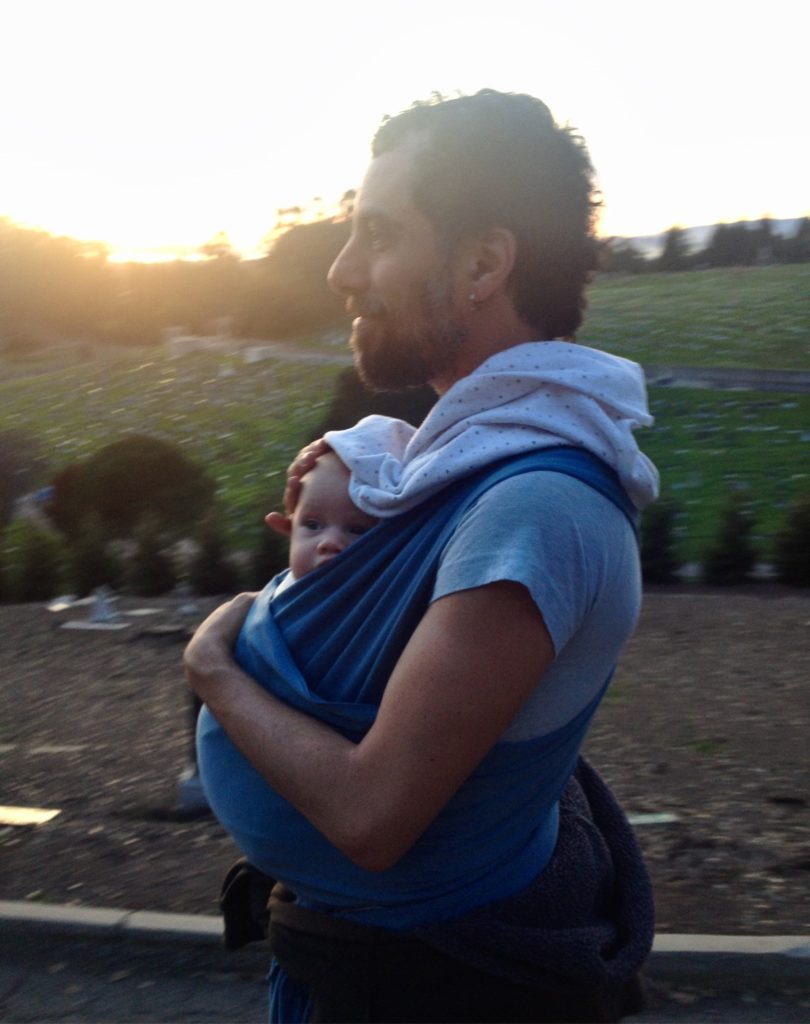Hi. I’m Dr. Sean Oakes.

Here’s a photo from a few years ago, when my son River was just a few months old. Now he’s a bouncy, talkative 5 year old! And I’m a less bouncy, but still talkative, 50 year old. My partner Sara, River, and I live in Oakland, California, in the Temescal neighborhood. Our house is a few yards from Temescal Creek, now underground.
I’ve been in the Bay Area since I was one, and grew up out in Livermore, which was then a rodeo and vineyards town with a national laboratory (where my father worked), and now is one of the perimeter suburbs of Silicon Valley. This is land tended for 2500 years by the Ohlone and Miwok peoples, until the Spanish colonized “Alta California” in 1804, and the Americans “bought” the land (for $15M) in 1848 after defeating the Spanish in the Mexican-American War. These Brits and Spaniards are my cultural ancestors. I was adopted at birth from an American mother of British descent, Episcopals, and a Puerto Rican father of Spanish descent, Pentecostals. My adoptive parents were Catholics, from Italian and German immigrant families.
I grew up focused on classical music, and played violin, church organ, piano, and double bass, as well as singing and doing theater. My path in the arts took me from classical music to experimental modern composition, then into music for dance, performance art, and many kinds of movement work, including contact improvisation, authentic movement, Yoga, Butoh, and other kinds of somatic movement process. My arts life peaked with my getting an award for my work with an experimental circus, Circo Zero, and eventually getting a PhD in Performance Studies.
While I was training in all that, I was also searching for a spiritual path that could really carry me through what I was noticing was a rather unsatisfying existence, and I found Buddhism initially through Chinese nature poems. I trained in Zen for 6 years, then Insight Meditation (Thai Forest & Burmese Theravāda lineages) for 20, including a few years (cumulatively) of silent retreat, and a season as an ordained monastic (bhikkhu) in Burma/Myanmar.
My teacher Jack Kornfield encouraged me to start teaching in 2010, and to get a day job, which partly motivated the PhD. He also sent me to train in trauma, and I studied Somatic Experiencing and Organic Intelligence with Steven Hoskinson, which has had a profound effect on both my own healing path and my teaching. It turns out that all the disciplines were aiming for the same thing: getting to the root of why this life, despite all the privileges I grew up with, was so painful.
Gotama, the young man in ancient South Asia we now call The Buddha, seems to have had a similar kind of search, and I resonate in so many ways with his descriptions of the difficulties of life. And now, having immersed myself for my whole adult life in the discipline he crafted, I feel the blossoming of a strange confidence. A faith. That the path he laid out, called the Noble Eightfold Path, works.
The Buddhist tradition, especially for me the teachings preserved by the Theravāda schools in the Pāli Canon, describes the cause of emotional and existential pain so clearly. And then lays out a discipline through which we can undo the ancient tangled threads of ancestral trauma and inherited psychological baggage that prevent us from resting in the clarity and joy that is natural, once these wounds have been healed. This is true both for us as individuals, and for us as families, communities, and cultures, because every complex system follows the same underlying principles. Some of the most inspiring and necessary work in the Buddhist world right now is the unfolding conversation between the individual and communal approaches to practice; between the renunciate and engaged orientations to liberation.
May our practice together unfold in ever-deepening circles,toward healing and liberation for each of us as individuals,
and for our families, communities, and cultures.
May our practice and all the choices we make
be in service of well-being for our beloved planet
and all beings who share this precious home.